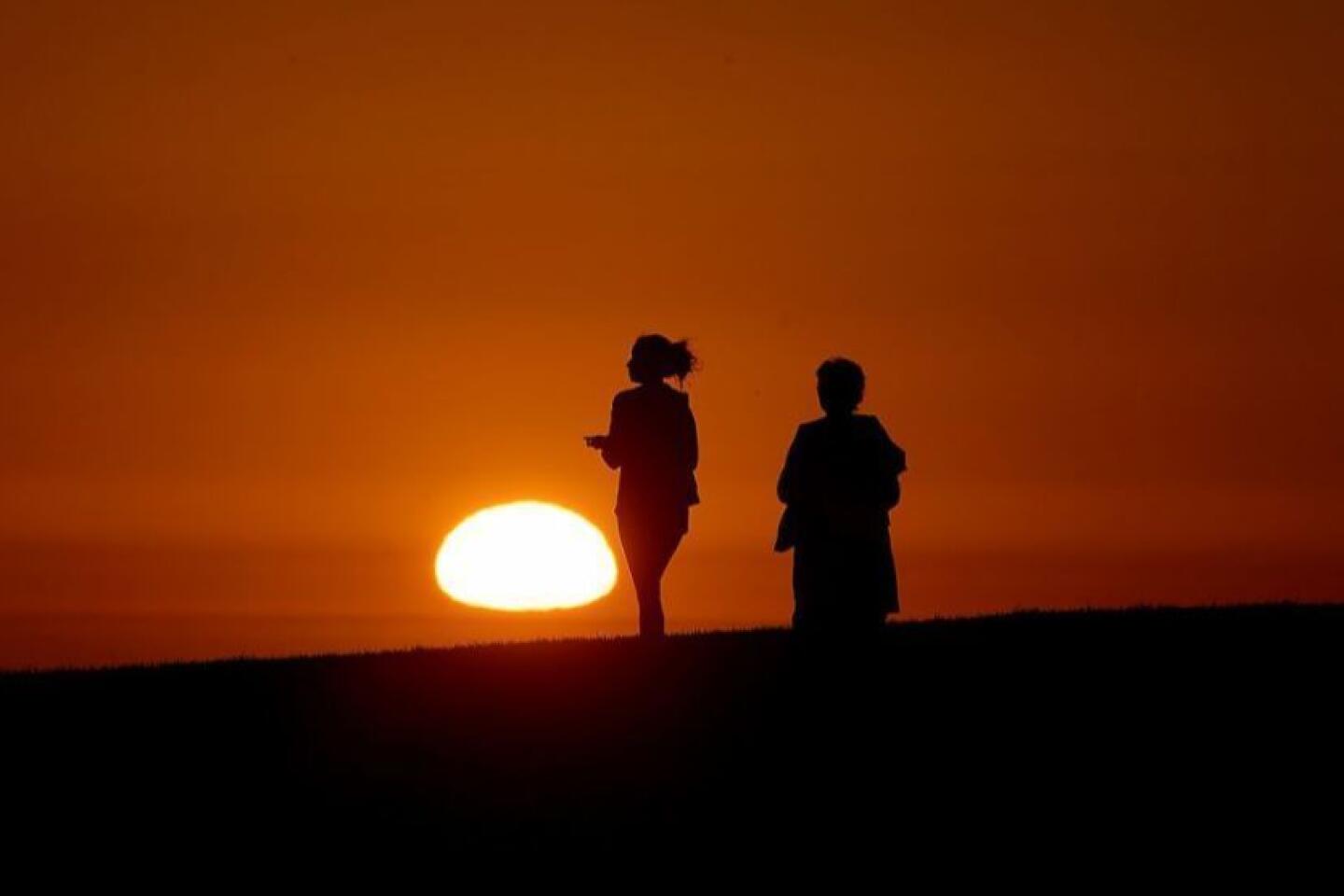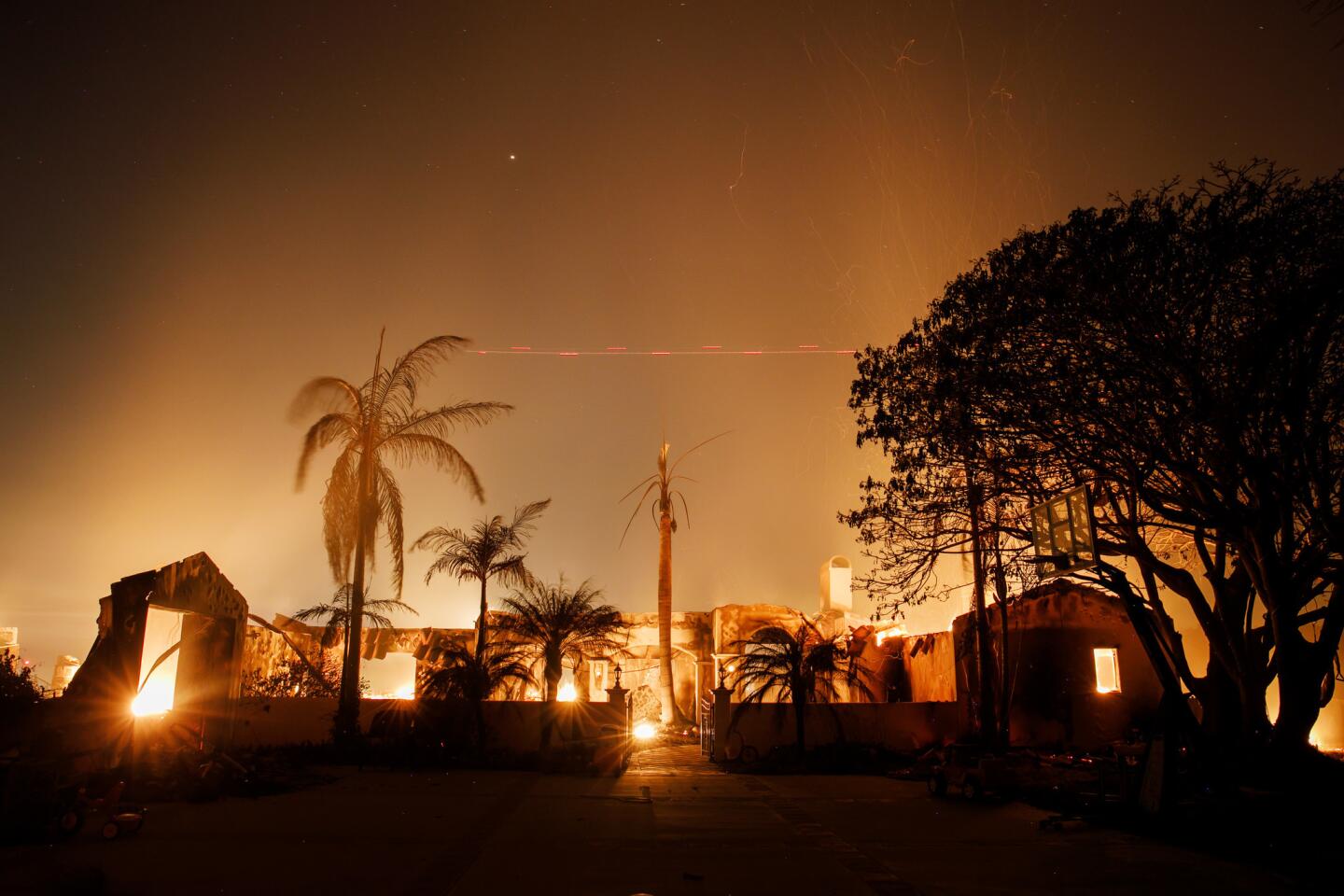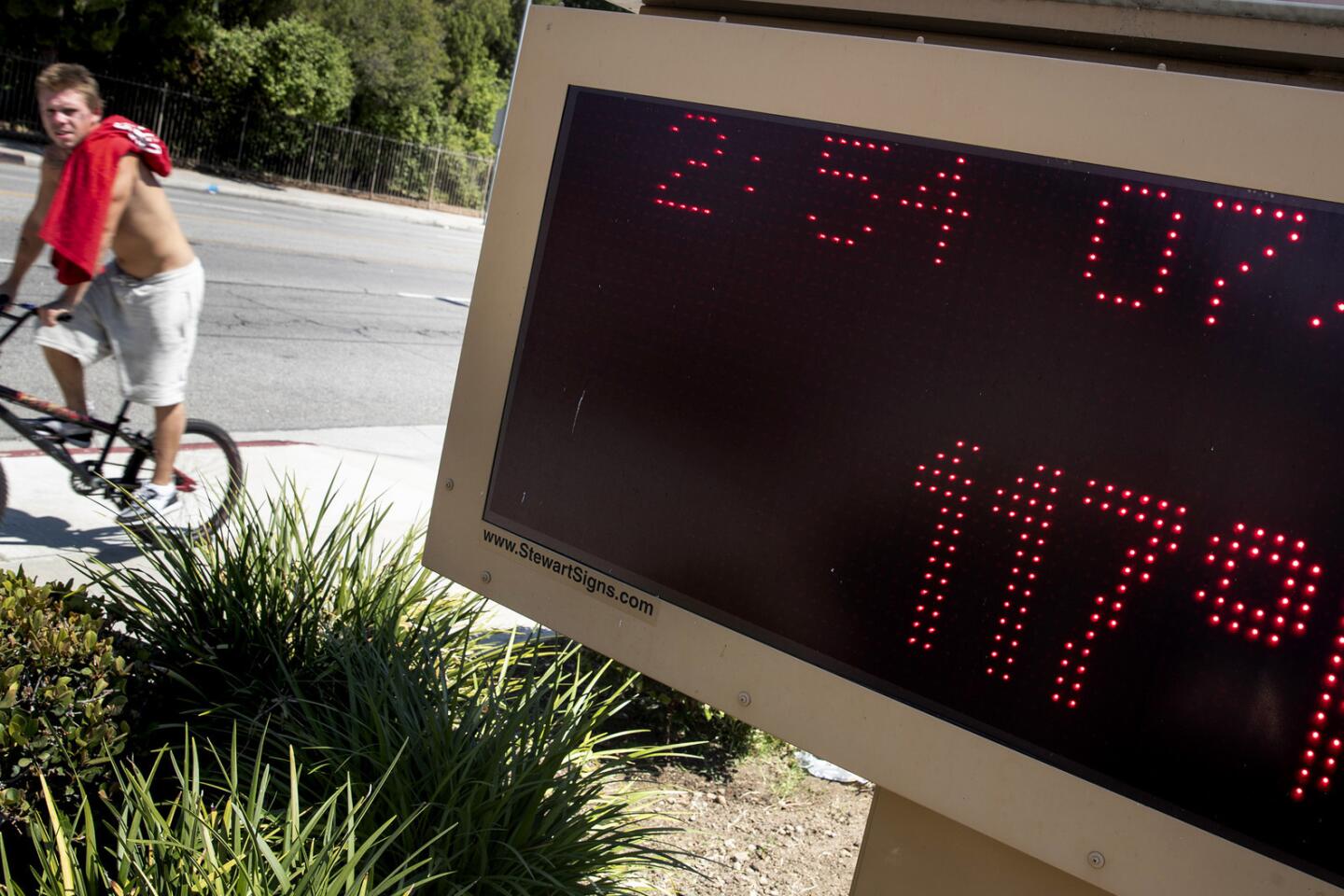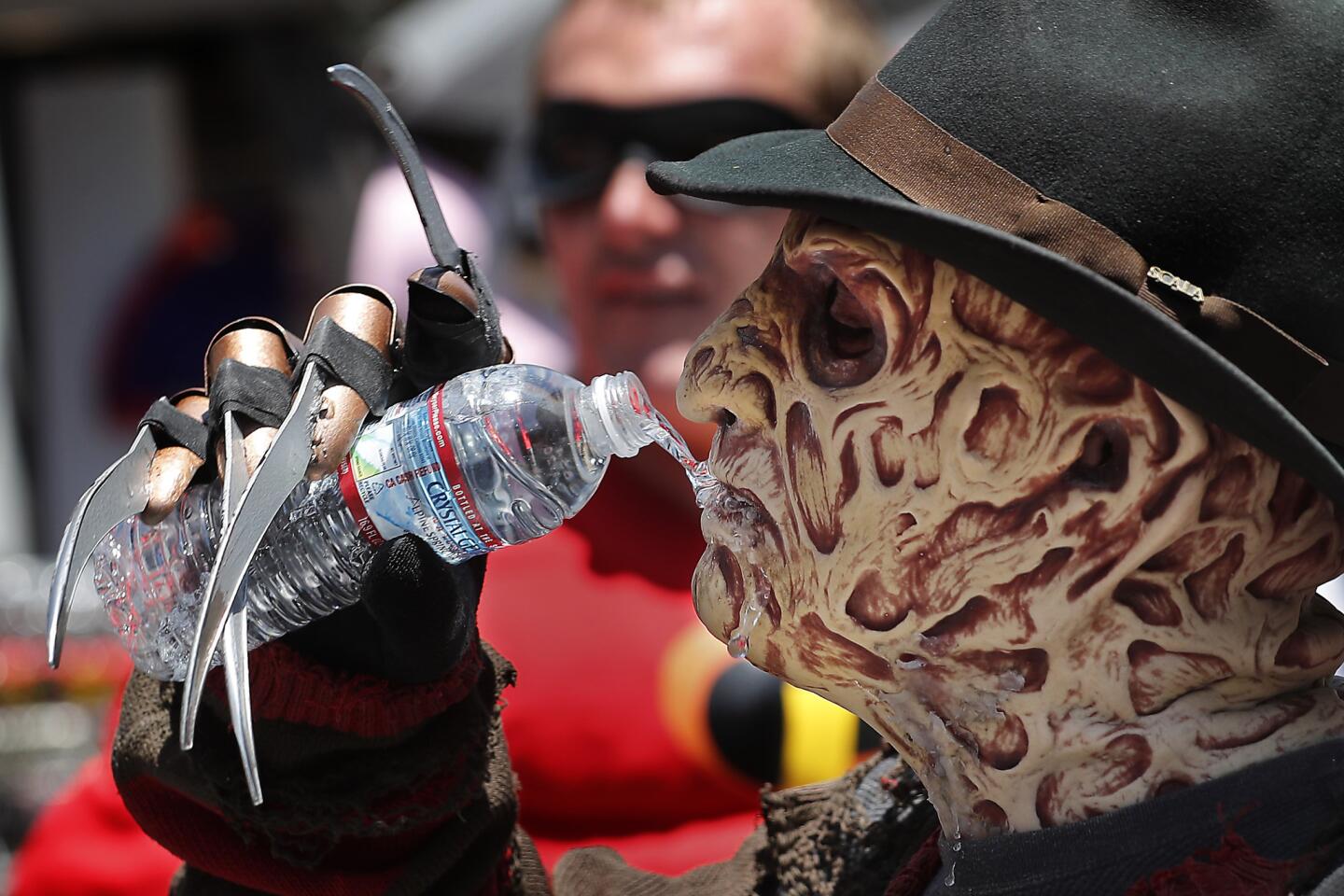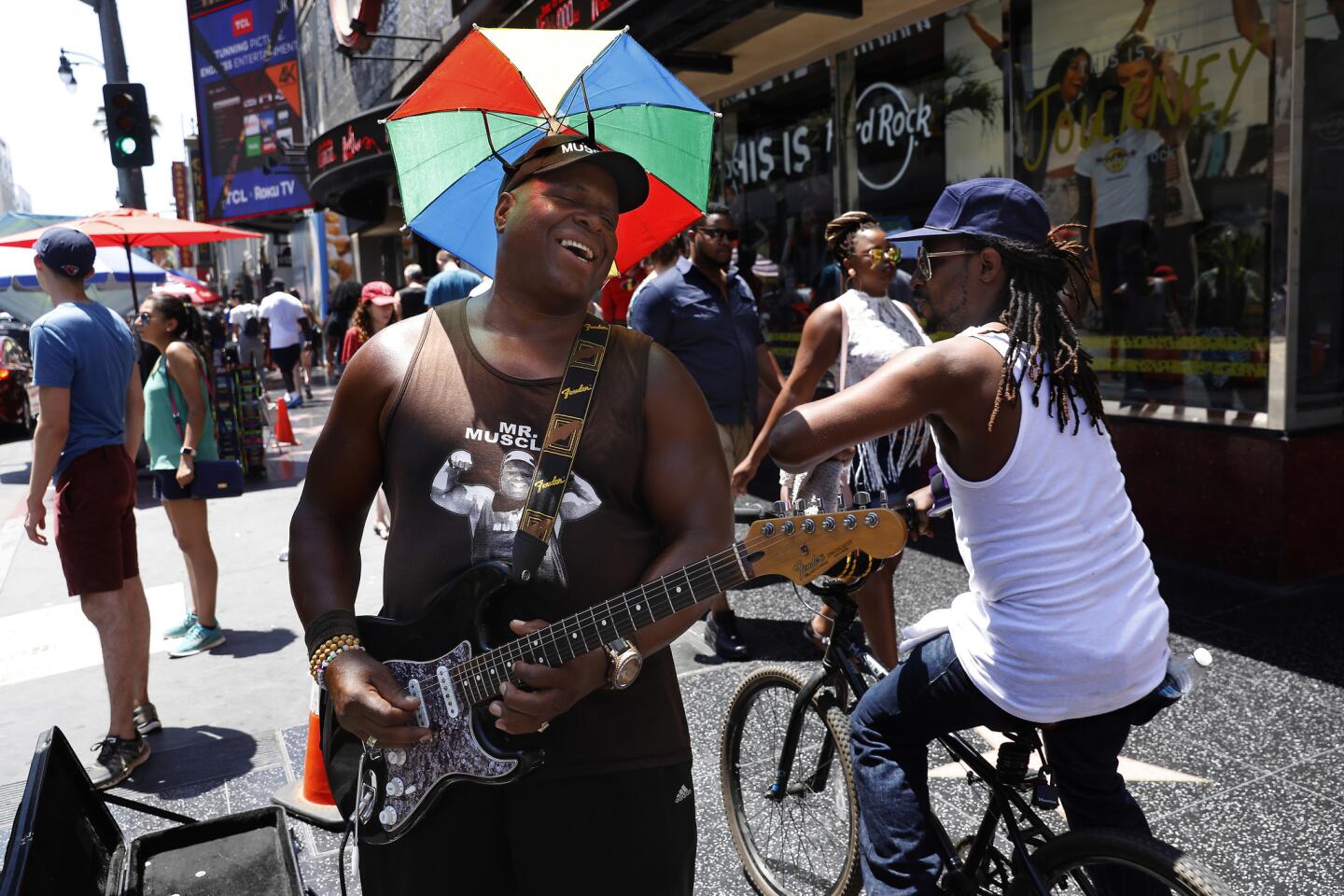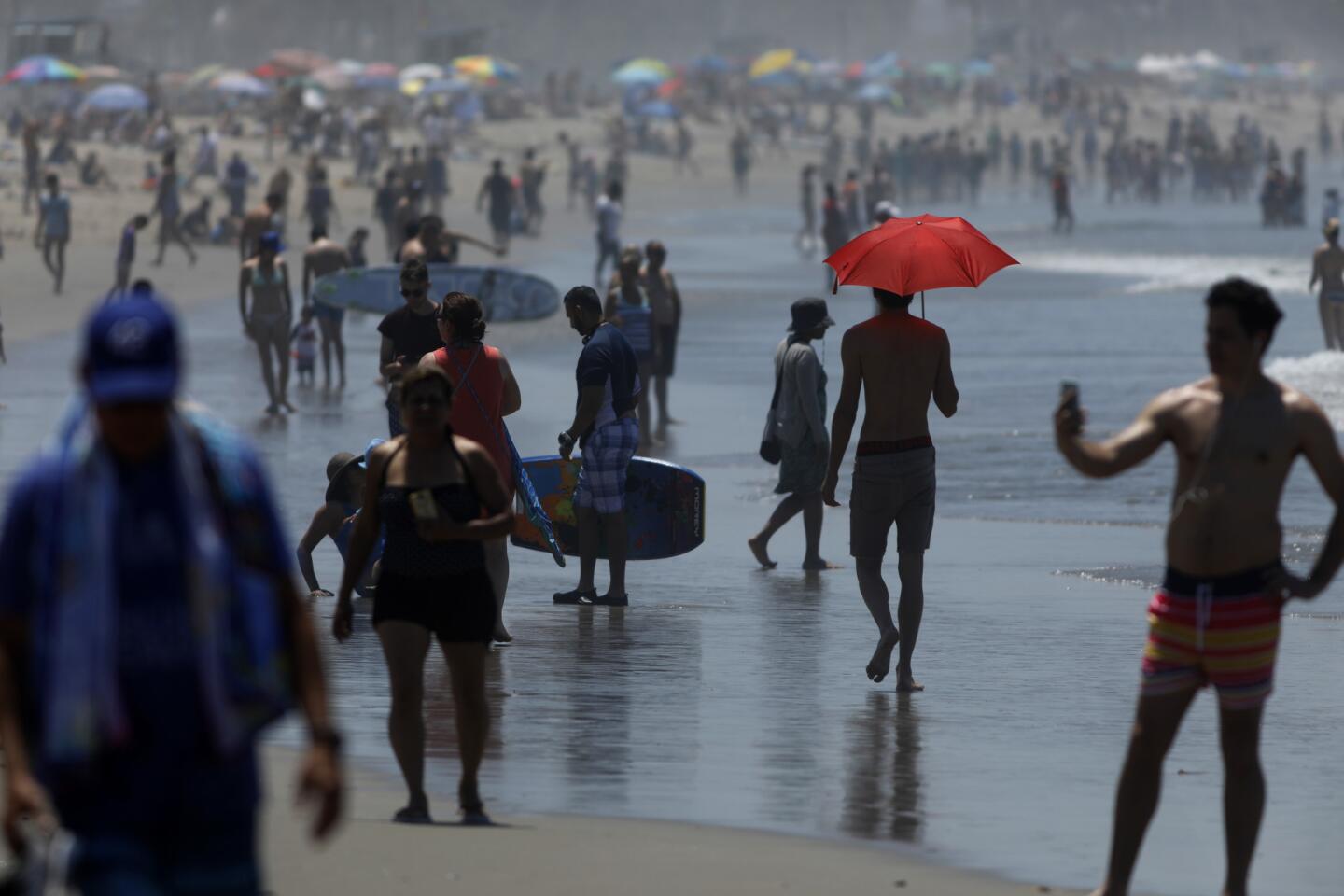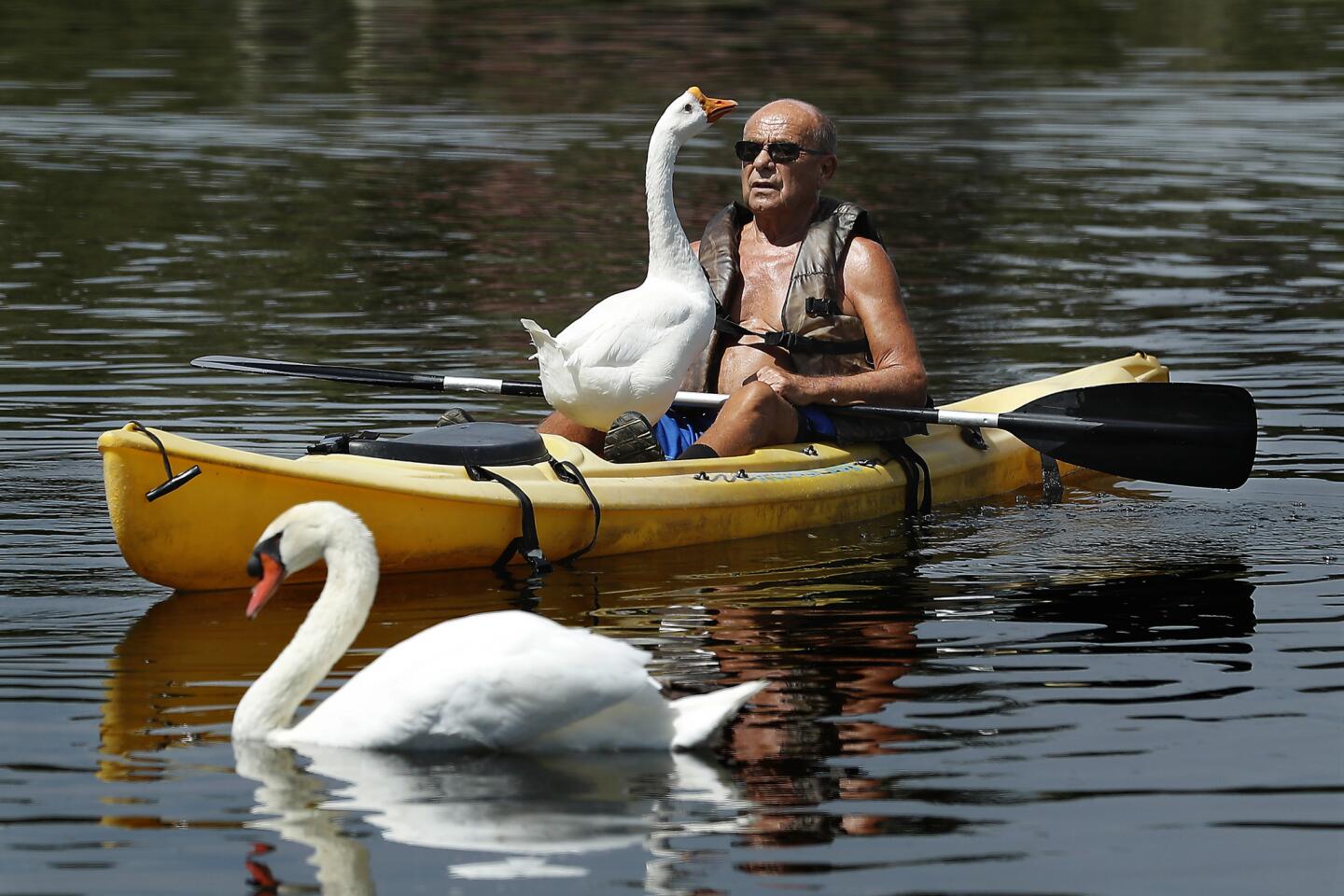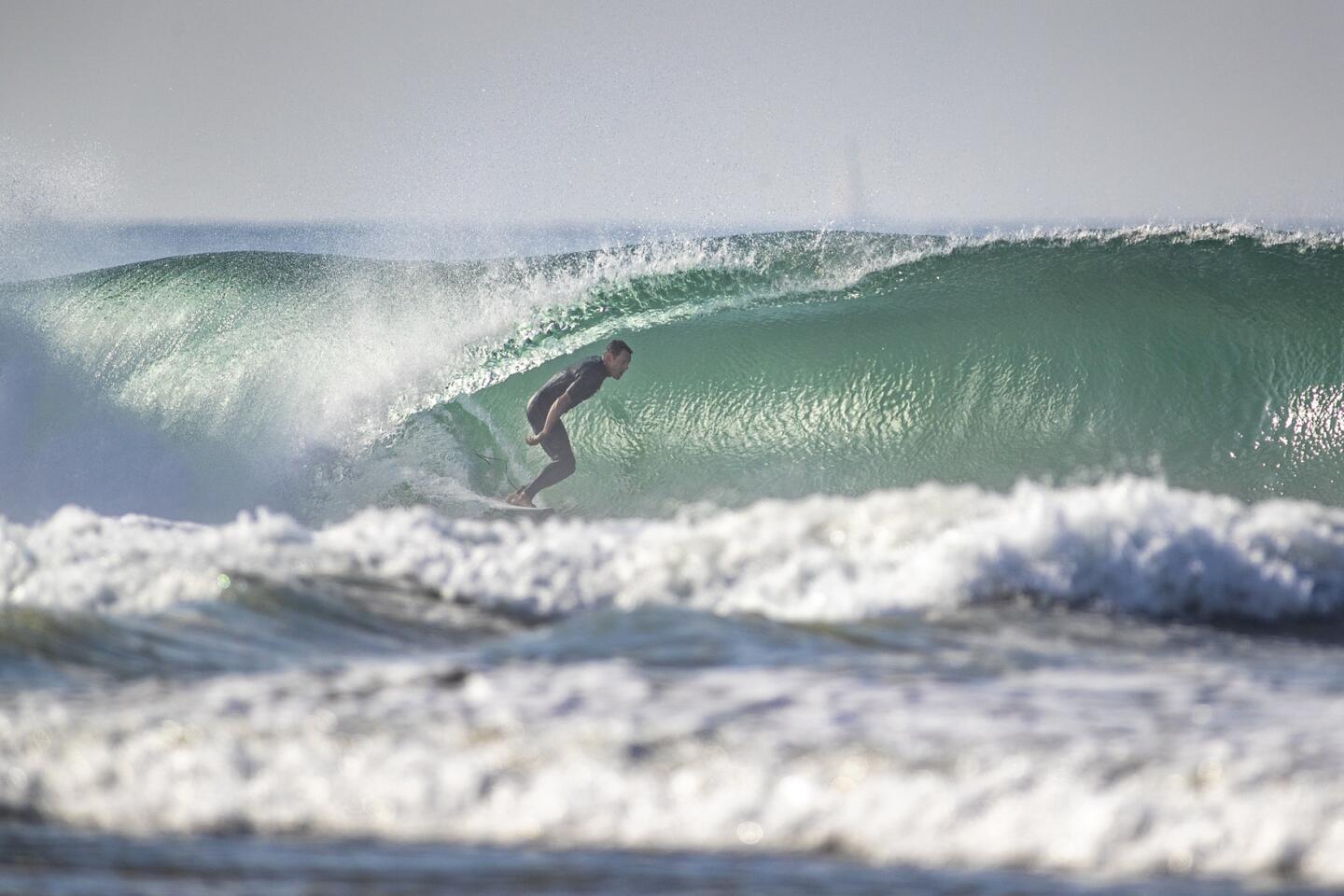Fire crews make progress in Goleta as some residents return to find charred ruins

Firefighters work overnight battling a destructive fire that snaked through a hillside area of Goleta, one of several blazes that destroyed homes amid a record-setting heat wave in Southern California.
- Share via
Reporting from GOLETA, Calif. — Firefighters on Saturday continued to battle a destructive fire that snaked through a hillside area of Goleta in Santa Barbara County, one of several blazes that destroyed homes amid a record-setting heat wave in Southern California.
Fire personnel spent the night and morning in pitched battle against the Holiday fire, which exploded Friday night amid 100-degree temperatures and dangerous sundowner winds that made the blaze impossible to control, prompting hundreds of residents to evacuate.
But fire crews made significant progress Saturday, and by 5 p.m. the 400-acre fire was 80% contained, Santa Barbara County Fire Chief Eric Peterson told reporters at an afternoon news conference. Full containment is expected by Wednesday.
There were no reports of deaths or major injuries, and Peterson commended residents for quickly evacuating their homes.
“I’m convinced with that quickly advancing flame front, we would have had fatalities last night,” he said. “This scene has been repeated far too many times in our country over the last few years, and all of our hearts go out to those people who lost everything.”
More than 2,500 people were initially evacuated, but that number was reduced Saturday to about 600, Santa Barbara County Sheriff Bill Brown said. Officials also backed away from earlier estimates that 20 homes were destroyed, calling it “a pure guess” and saying that homes were still being evaluated for damage.
The blaze moved so fast Friday night that some residents struggled to get out of the hillside community, and 911 lines were jammed with calls. It was burning north of Cathedral Oaks Road, west of Fairview Avenue and east to Patterson Avenue.
The Holiday fire is the latest event in a destructive year in Santa Barbara County at the hands of Mother Nature. In December, the Thomas fire, the largest wildfire on record in California, ripped through Montecito, Carpinteria and other coastal cities, destroying several homes. Then in January, mudslides in the same area killed 20 people and destroyed still more homes.
Santa Barbara County Supervisor Janet Wolf, who attended Saturday’s news conference, recalled losing her home during the Painted Cave fire of 1990. She said she has been forced to evacuate her home twice since then.
“Unfortunately, it is an occurrence that we have become very used to,” said Wolf, who took in some friends who evacuated their homes Friday night. “But that doesn’t take away from the trauma and the fear that people experience.”
Friday marked a grim beginning to what fire officials have warned will be another year of extreme fire danger, as much of Southern California remains under drought conditions. Last year was the worst fire season on record in the state, with thousands of homes lost and dozens killed — from Northern California wine country south to Los Angeles and San Diego counties.
The fire in Goleta was fueled by sundowner winds — notorious in the region and responsible for many of the area’s most devastating fires over the years — as well as record temperatures that stayed above 100 degrees well into Friday night.
Goleta residents Carrie Givens, 63, and her husband, John, 67, lost their home of 25 years. Their four-bedroom, split-level house was built into a hillside overlooking their 10-acre organic vegetable farm.
When she heard the wind pick up Friday night, Givens said she looked out and saw the fire outside.
“The way the winds were, as soon as we saw it started, I said, ‘We gotta get out of here,’” she said.
She grabbed a change of clothes, her passport, computer, camera and a pastel painting she had started. The couple also packed up their five cats and spent the night at a residence on one of their other properties.
Givens said she couldn’t save the finished paintings and expensive pastels in her art studio, her late mother’s ashes or the baby photos of her three children.
“That makes me sick,” she said.
As she lay down to sleep Friday night, Givens said she couldn’t stop thinking about her house. She envisioned the front door, the steps that opened up to their large living room with its high ceiling. She imagined sleeping in her own bed, on her own pillow.
When she and John returned to the house at 7 a.m. Saturday, it was all gone.
Despite living in an area plagued by fires, Givens said she never imagined she’d end up the victim of one. There were a couple of close calls, most recently the Gap fire in 2008.
On the agenda Saturday was calling the family’s insurance company and canceling a flight the next day to Mexico. Examining the loss, Givens noted that some of her mother’s garden gnomes had survived, as well as a small garden fountain and a colorful flowerpot.
“I kind of fell apart when I first walked up to it,” she said, “but what can you do? We’re all OK. We’ll be all right eventually.”
On Saturday morning, Eric Durtschi, 42, surveyed the charred remains of his rented hilltop home on Cuesta Verde in Goleta. He bent down and picked up the metal bones of three vintage rifles.
“This one’s the 1873 Winchester,” he said, studying one of them before turning to another. “This is my grandfather’s right here.”
Durtschi, his wife and their six children just moved into the house two weeks ago. They were still unpacking when the blaze forced them out Friday night and destroyed their home by morning. Durtschi said he didn’t yet have rental insurance.
The family had relocated from Utah after the school year ended to be near Durtschi’s business partner in their chocolate company. On Friday, two friends from Utah and their three children were visiting for the weekend when Durtschi’s daughter smelled smoke shortly before 9 p.m.
Durtschi walked outside and saw smoke everywhere. He told his wife to get the kids ready to leave, hopped in his truck and saw a wall of flames racing down the road toward them.
He called his wife at 8:49 p.m., told her to pack the essentials and to leave immediately. Meanwhile, he and his friend stayed behind to grab his father’s guitar and his journals, photographs and a hard drive.
“When we came out, there were fist-sized embers falling all over the place,” he said.
Among some of the treasured items lost in the fire were an 8-foot-wide painting of a Nativity scene that Durtschi had given his wife, wood carvings her father had made, his motorcycle and their children’s bicycles.
The family stayed the night with friends in town, but Durtschi couldn’t sleep. He woke at 5 a.m. to inspect the remains of their belongings and to compose himself before going to Santa Barbara to pick up his two oldest sons, who had been with a church youth group all week and didn’t know their home was gone.
“I need to come up with a plan and be strong so the kids aren’t more scared than they already are,” he said. “Hopefully people can learn. I learned a lot last night — I had no idea the flames could go that fast.”
Neighbors’ houses next door and across the street were safe, but his next-door neighbor’s home also burned. Around the corner, a team of Santa Barbara County firefighters was busy hosing down the inside of another home, sending a plume of smoke into the air.
Santa Barbara County sheriff’s officials are waiting to see how much of the fire can be contained before considering whether to let evacuated families back into their homes, said Kelly Hoover, a spokeswoman for the department.
“We’re trying to remind people that even though it may look better during the daytime, it can be deceiving because nightfall comes and the wind starts whipping up again and you just never know what’s going to happen,” she said.
The American Red Cross set up a shelter for evacuees at the Goleta Valley Community Center. Sixty-one people stayed overnight, said spokeswoman Cindy Huge. Most were over age 65 and only a few were children.
By the afternoon, just a few people remained, including a man who had brought his cot outside to nap with his Labrador retriever under a gondola as a gentle breeze passed through.
Aaron Bluitt, 45, sat in the shade just outside the center. He, his mother and his uncle had been evacuated from their home at Cathedral Oaks Road and North Patterson Avenue Friday night.
He grabbed mostly the essentials — extra clothes and toiletries — but also brought family photo albums and books that had been passed down through generations.
The family intended to stay at a hotel. But Bluitt said he called several that had no vacancies before deciding to head to the community center.
They ran into trouble when Spirit, the Chihuahua and Jack Russel terrier mix puppy he was dog sitting for a family member, escaped amid the chaos of the evacuation, darting out into the neighborhood. Bluitt said he tried looking for her but eventually decided they needed to get to safety.
Luckily, neighbors called before midnight. They had managed to grab Spirit and kept her safe until Bluitt could be escorted back to the neighborhood to retrieve her.
Adrenaline kept Bluitt from sleeping Friday night. On Saturday, he stayed tuned to updates by officials, hoping he’d be allowed back home.
“We’re hoping for the best,” he said.
Goleta was one of numerous flashpoints Friday as fires broke out across Southern California amid record-setting heat.
Firefighters battled blazes in Alpine, Camp Pendleton, the San Fernando Valley, Cajon Pass, Forest Falls and Montecito Heights.
The fire in Alpine, dubbed the West fire, hopscotched through parched canyons, destroying 18 structures, damaging several more and scorching about 400 acres, officials said. One firefighter was taken to a hospital with facial burns and was reported in good condition.
But fire crews battling the blaze made significant progress overnight as erratic winds began to die down. By 7:30 a.m. Saturday, the West fire was 30% contained, officials said.
“Crews are making good progress,” said Cal Fire Capt. Kendal Bortisser. “Damage assessment teams are still out there. There are still some areas they haven’t gotten into. The number of structures destroyed and damaged will likely go up as they continue to work on their assessment.”
The fire was first reported about 11:20 a.m. south of Interstate 8 near the West Willows Road offramp. Pushed by winds gusting up to 19 mph, it had consumed 150 acres by 1 p.m. and 350 acres by 2:30 p.m., as temperatures hit 108 degrees.
Citing the high temperatures, low humidity and erratic winds — “conditions of extreme peril to the safety of persons and property” — Gov. Jerry Brown declared a state of emergency. .
Several of the homes lost in the West fire were at Alpine Oaks Estates, a 66-space mobile home park on Alpine Boulevard near the Cleveland National Forest. Officials said an undetermined number of other houses had been destroyed or damaged along the community’s winding roads, many of them set alight in spot fires caused by swirling embers.
“There are homes that are perfectly untouched, and others that are burned to the ground,” said Bill Paskle, chief of the Alpine Fire Protection District.
An overnight shelter was set up at Los Coches Creek Middle School on Dunbar Lane.
“We just grabbed everything you can’t replace or rebuy,” said Ben Stanfill, who was at the shelter late in the day after a frantic evacuation of his mother’s house. “My grandma’s photographs, the cat, my sister’s Mickey Mouse teddy bear she’s had since she was little.”
The house was not in the mandatory evacuation zone, but the family just wanted to be safe, Stanfill said. He didn’t know how close the flames had come.
“Now we just wait and see,” he said, sitting on a rock outside the shelter, sweating.
By 2 p.m., authorities had lifted evacuation orders in several areas, including the Palo Verde Ranch and Rancho Palo Verde communities as well as areas west of South Grade Road.
But many areas would probably remain off-limits throughout the night, including Suncrest Vista Lane, Highlands View Road, Manzanita View Road, Olive View Road, Scenic View Road, Scenic View Place, Pine View Road, Viejas View Place, Sage View Drive, Oak View Road, Verde View Road, Calle Caleta Viejas and Via La Mancha.
Some residents returned to find nothing left.
A little after 9 a.m., a couple with their teenage son pulled up to their lot on Olive View Road. The husband and wife stood at the base of their 75-foot driveway, hugging and looking at the smoldering ruins that had been their home of 17 years.
A member of law enforcement, the homeowner had been allowed past roadblocks with his family. They weren’t really surprised at what they found.
“I was out of town and saw my house burning from the airplane,” said the owner, who asked that his identity not be disclosed because of his line of work.His wife and two children had safely evacuated at the beginning of the fire, he said.
“The important things survived,” he said.
By Saturday morning, the Valley fire in San Bernardino County had grown to 1,000 acres, threatening hundreds of homes and prompting evacuations of some communities, according to the Fire Department.
The uncontained blaze continues to move north and east, pushing higher into the San Gorgonio Wilderness Area, officials said.
No homes have been destroyed, said Cathey Mattingly, public information officer for the California Department of Forestry and Fire Protection.
Highway 38 remained closed from Bryant Street up to Lake Williams Drive.
About 500 personnel were on scene, including Cal Fire, San Bernardino County Fire, the U.S. Forest Service and the San Bernardino County Sheriff’s Department.
The blaze is climbing steep terrain, Mattingly said. While humidity remained low, wind conditions were calmer than Friday night, which should help firefighting efforts, she said.
Many parts of Southern California hit new high-temperature marks Friday, with a few spots reaching the hottest readings recorded. Among the places that set records were Van Nuys Airport (117 degrees), Burbank Airport (114), Santa Ana (114) and Ramona (115), according to the National Weather Service.
The heat wave continued Saturday, but temperatures were slightly lower than on Friday.
Wilkens and Figueroa write for the San Diego Union-Tribune.
UPDATES:
6:40 p.m.: This article was updated with new information from Santa Barbara County officials.
5:05 p.m.: This article was updated with new information about the Alpine fire in San Diego County.
3:30 p.m.: This article was updated with new information about Goleta evacuation center.
Noon: This article was updated with new information on the Valley fire in San Bernardino County.
11:05 a.m.: This article was updated with comments from a Goleta couple who lost their home.
10:45 a.m.: This article was updated with new information about the West fire in San Diego County.
10 a.m.: This article was updated with comments from a Goleta resident who lost his home.
8:55 a.m.: This article was updated with information about last year’s destructive fire season.
8:45 a.m.: This article was updated with previous natural disasters in Santa Barbara County.
8:15 a.m.: This article was updated with new figures on acres burned and people evacuated in the Goleta fire.
This article was originally published at 7:10 a.m.
More to Read
Sign up for Essential California
The most important California stories and recommendations in your inbox every morning.
You may occasionally receive promotional content from the Los Angeles Times.
